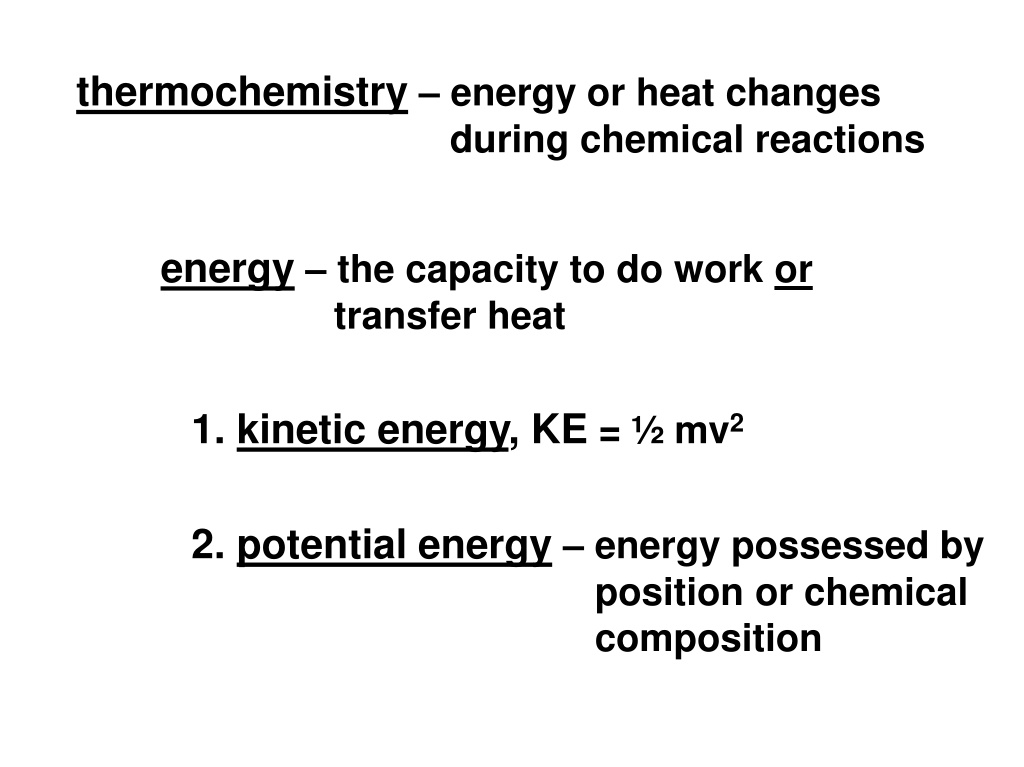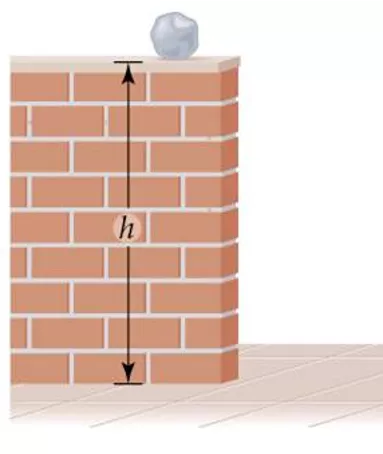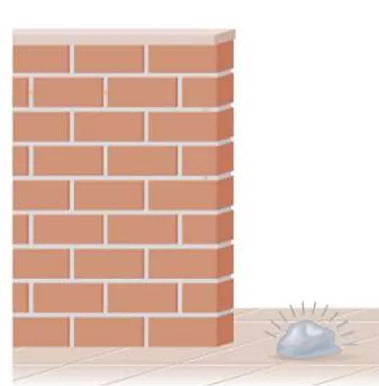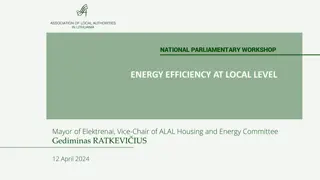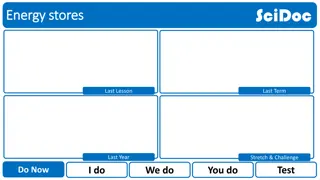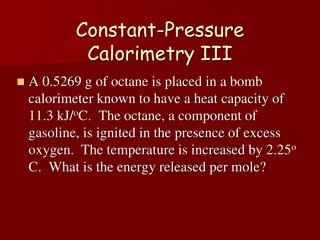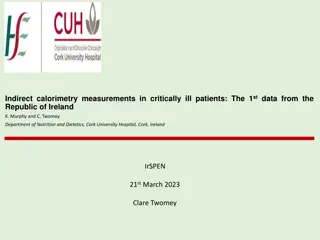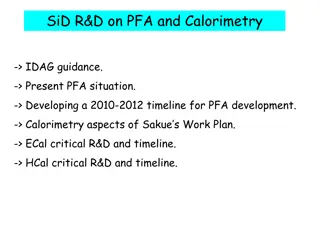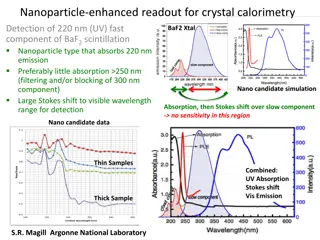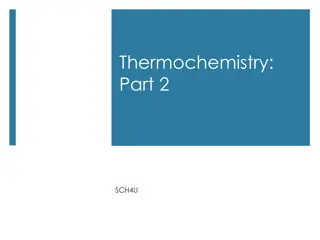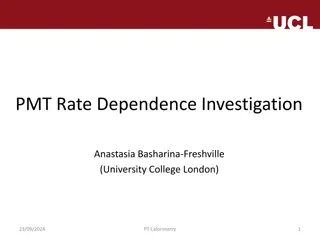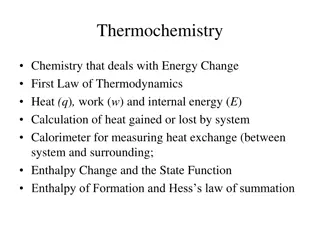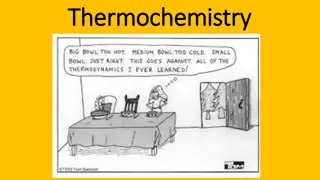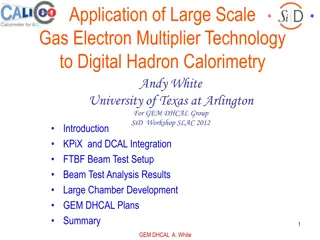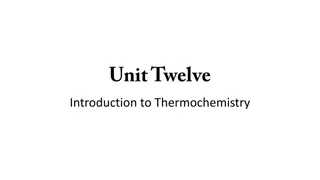Thermochemistry: Energy Changes and Calorimetry
Concepts of energy changes during chemical reactions, the first law of thermodynamics, specific heat, and calorimetry. Understand the transfer of heat between objects and how to calculate heat changes in various systems.
Download Presentation

Please find below an Image/Link to download the presentation.
The content on the website is provided AS IS for your information and personal use only. It may not be sold, licensed, or shared on other websites without obtaining consent from the author. Download presentation by click this link. If you encounter any issues during the download, it is possible that the publisher has removed the file from their server.
E N D
Presentation Transcript
thermochemistry energy or heat changes during chemical reactions energy the capacity to do work or transfer heat 1. kinetic energy, KE = mv2 2. potential energy energy possessed by position or chemical composition
rock has potential energy due to it s position but no KE PE decreasing while KE increasing traded PE for KE
Joule, J SI unit of energy 1000 J = 1 kJ calorie, cal = 4.184 J (exactly) system stuff directly involved in the process surroundings the environment the system affects Heat lost by the system is equal to the heat gained by the surroundings
1st Law of Thermodynamics energy cannot be created or destroyed, only transferred from one place to another heat, q the energy transferred between objects of different temperatures exothermic system liberates heat. q = # endothermic system absorbs heat. q = + #
endothermic exothermic q = # q = + #
calorimetry the science of measuring heat changes specific heat the heat required to raise 1 g of substance by 1 C units for specific heat are: J/g C q = (specific heat) (mass) ( T) T = Tfinal- Tinitial heat sp. ht. g
How much heat is required to raise 16.93 g H2O from 18.2 C to 84.3 C ? Two methods for measuring heat changes 1. Constant pressure calorimetry (coffee cup calorimetry) 2. Constant volume calorimetry (bomb calorimetry)
1. Constant pressure calorimetry (coffee cup calorimetry) 15.049 g Al (s) was heated to 97.2 C then dumped into 81.432 g H2O at 21.3 C. The temperature of the H2O rose to 24.2 C. What is the specific heat of Al (s) ?
Heat lost by the system is equal to the heat gained by the surroundings Heat lost by the Al (s) is equal to the heat gained by the H2O ( ) -qmet = qw -qmet = qw = 988 J -qmet = 988 J qmet = -988 J
2. Constant volume calorimetry (bomb calorimetry) 1. put in material to burn 2. pump in lots of oxygen, O2 3. put bomb in a container of water 4. combust it and measure the temperature increase
heat capacity, C the T experienced by an object when heat is absorbed units for heat capacity are J/ C (or kJ/ C) 1.236 g C3H8 and excess O2 was placed into a bomb calorimeter and submerged in H2O then combusted. The temperature rose from 21.13 C to 33.49 C. The heat capacity, Cbomb = 5.03 kJ/ C. How much heat in kJ, kJ/g and kJ/mole did the combustion reaction liberate ?
Heat liberated by the system is equal to the heat gained by the surroundings Heat liberated by the combustion reactionis equal to the heat gained by the bomb calorimeter apparatus -qrxn = qbomb -qrxn = qbomb = 62.1708 kJ -qrxn = 62.1708 kJ qrxn = -62.1708 kJ
enthalpy, H heat content measured when the pressure remains constant
standard heat of formation the H (heat) that accompanies the formation of 1 mole of anything from it s free, uncombined elements at standard conditions f H standard conditions 25 C and 1 atm pressure f H 1. units for are kJ/mole 2. coefficients represent number of moles 3. product must be formed from free, uncombined elements
f H Write the reaction describing the of NaCl (s) f H = -410.9 kJ/mole NaCl (s) Na (s) Cl2 (g) +
standard heat of reactionthe H (heat) that accompanies ANY reaction under standard conditions (units are kJ) H rxn H rxn = [(sum products) (sum reactants)] f H f H 1. write and balance the reaction 2. use table of thermodynamic data of to calculate f H H rxn
Determine the for the combustion of ammonia rxn H 3 6 4 NH3(g) + O2(g) N2(g) +H2O(g) 2
H rxn Determine the for the following reaction at 84 C and 0.79 atm 2 3 N2O(g) + O2 (g) 4 NO2 (g)
